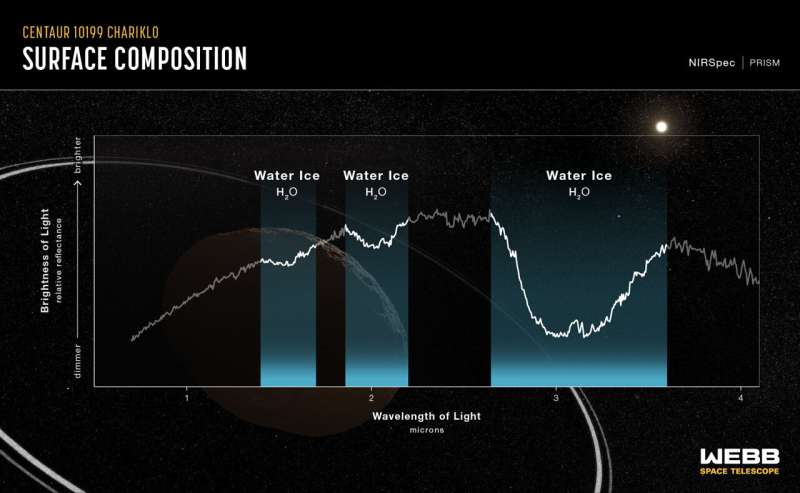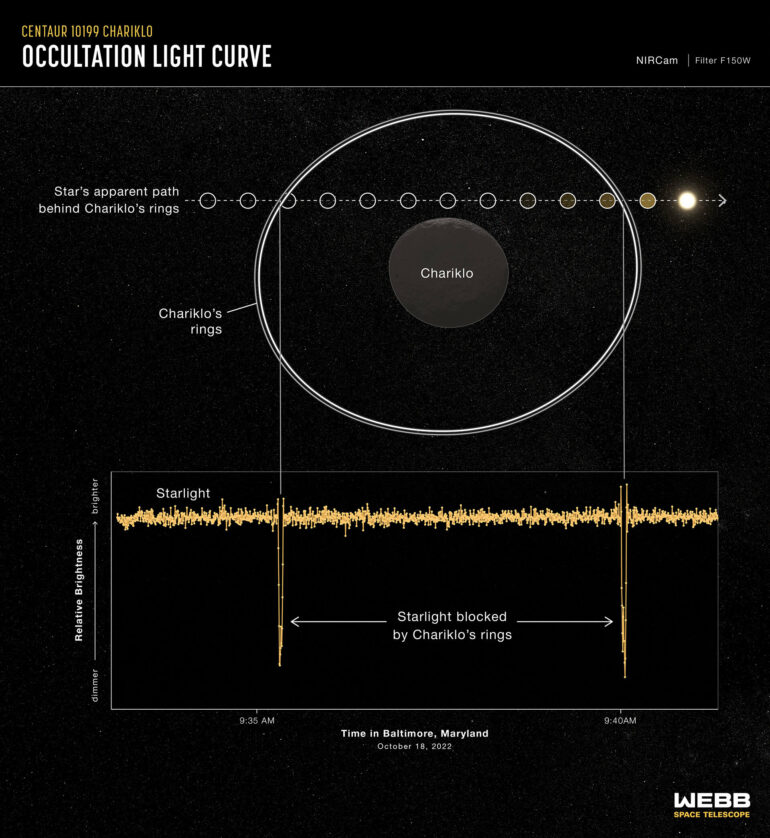In 2013, Felipe Braga-Ribas and collaborators, using ground-based telescopes, discovered that Chariklo hosts a system of two thin rings. Such rings had been expected only around large planets such as Jupiter and Neptune.
The astronomers had been watching a star as Chariklo passed in front of it, blocking the starlight as they had predicted. Astronomers call this phenomenon an occultation. To their surprise, the star blinked off and on again twice before disappearing behind Chariklo, and double-blinked again after the star reemerged. The blinking was caused by two thin rings—the first rings ever detected around a small solar system object.
Pablo Santos-Sanz, from Instituto de Astrofísica de Andalucía in Granada, Spain, has an approved “Target of Opportunity” program (program 1271) to attempt an occultation observation as part of Webb’s solar system Guaranteed Time Observations (GTO) led by Heidi Hammel from the Association of Universities for Research in Astronomy.
By remarkable good luck, they discovered that Chariklo was on track for just such an occultation event in October 2022. This was the first stellar occultation attempted with Webb. A lot of hard work went into identifying and refining the predictions for this unusual event.
On Oct. 18, they used Webb’s Near-Infrared Camera (NIRCam) instrument to closely monitor the star Gaia DR3 6873519665992128512, and watch for the tell-tale dips in brightness indicating an occultation had taken place.
The shadows produced by Chariklo’s rings were clearly detected, demonstrating a new way of using Webb to explore solar system objects. The star shadow due to Chariklo itself tracked just out of Webb’s view. This appulse (the technical name for a close pass with no occultation) was exactly as had been predicted after the last Webb course trajectory maneuver.
The Webb occultation light curve, a graph of an object’s brightness over time, revealed that the observations were successful The rings were captured exactly as predicted. The occultation light curves will yield interesting new science for Chariklo’s rings.
Santos-Sanz explains, “As we delve deeper into the data, we will explore whether we cleanly resolve the two rings. From the shapes of rings’ occultation light curves, we also will explore the rings’ thickness, the sizes and colors of the ring particles, and more. We hope gain insight into why this small body even has rings at all, and perhaps detect new fainter rings.”

Webb captured a spectrum with its Near-infrared Spectrograph (NIRSpec) of the Chariklo system on Oct. 31, shortly after the occultation. This spectrum shows clear evidence for crystalline water ice, which was only hinted at by past ground-based observations. © NASA, ESA, CSA, L. Hustak (STScI). SCIENCE: Noemí Pinilla-Alonso (FSI/UCF), Ian Wong (STScI), Javier Licandro (IAC).
The rings are probably composed of small particles of water ice mixed with dark material, debris from an icy body that collided with Chariklo in the past. Chariklo is too small and too far away for even Webb to directly image the rings separated from the main body, so occultations are the only tool to characterize the rings by themselves.
Shortly after the occultation, Webb targeted Chariklo again, this time to collect observations of the sunlight reflected by Chariklo and its rings (GTO Program 1272). The spectrum of the system shows three absorption bands of water ice in the Chariklo system.
Noemí Pinilla-Alonso, who led Webb’s spectroscopic observations of Chariklo, says, “Spectra from ground-based telescopes had hinted at this ice (Duffard et al. 2014), but the exquisite quality of the Webb spectrum revealed the clear signature of crystalline ice for the first time.”
Dean Hines, the principal investigator of this second GTO program, adds, “Because high-energy particles transform ice from crystalline into amorphous states, detection of crystalline ice indicates that the Chariklo system experiences continuous micro-collisions that either expose pristine material or trigger crystallization processes.”
Most of the reflected light in the spectrum is from Chariklo itself: Models suggest the observed ring area as seen from Webb during these observations is likely one-fifth the area of the body itself. Webb’s high sensitivity, in combination with detailed models, may permit us to tease out the signature of the ring material distinct from that of Chariklo. Pinilla-Alonso comments that “by observing Chariklo with Webb over several years as the viewing angle of the rings changes, we may be able to isolate the contribution from the rings themselves.”
The successful Webb occultation light curve and spectroscopic observations of Chariklo open the door to a new means of characterizing small objects in the distant solar system in the coming years. With Webb’s high sensitivity and infrared capability, scientists can use the unique science return offered by occultations, and enhance these measurements with near-contemporaneous spectra. Such tools will be tremendous assets to the scientists studying distant small bodies in our solar system.
Citation:
Webb spies Chariklo ring system with high-precision technique (2023, January 25)
